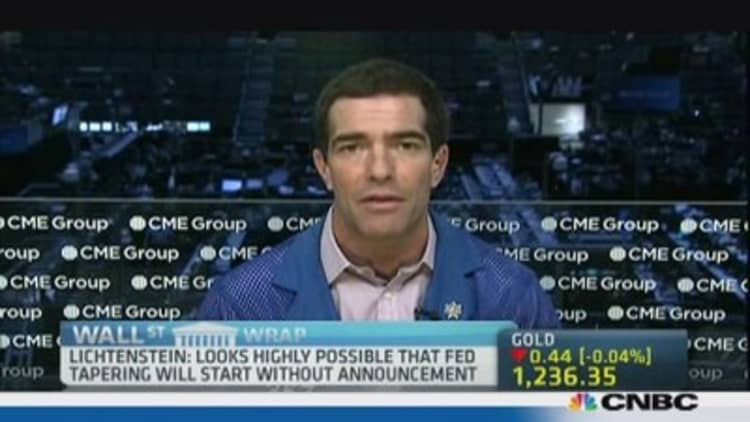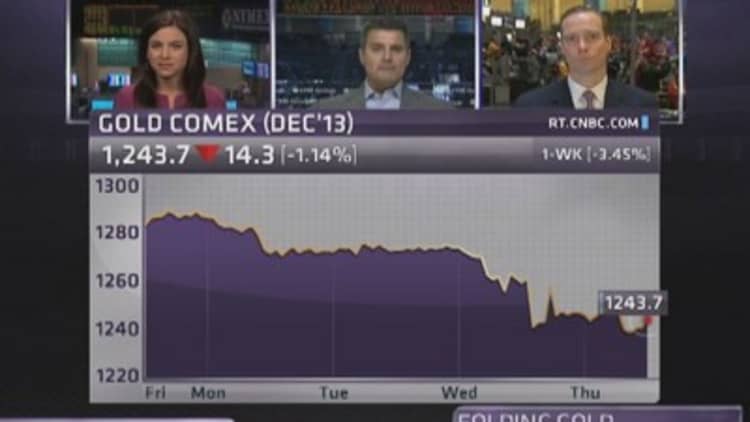
While investors continue to debate when the Federal Reserve will taper its asset-purchase program, one analyst told CNBC that they may have missed the boat - tapering may have already begun.
According to Ben Lichtenstein, president of Traders Audio, recent movement in U.S. bond yields, gold prices and the U.S. dollar show that the Federal Reserve may have already started reducing the size of its monthly asset purchases.
(Read more: Dollar to trade sideways, taper or no taper: charts)
"It feels a little odd that all investors and traders are waiting for some sort of announcement from the Fed to signify some sort of change in economic policy. It's more so the norm that the Fed actually starts to act prior to announcing or making it somewhat public. There is the potential that we are already seeing that right now," he told CNBC Asia's Squawk Box on Thursday.
When Fed chairman Ben Bernanke first uttered the T-word in May it sent global markets into a tizzy as investors panicked over how markets would cope without the steady flow of easy money that the Fed has provided since 2008.
Since then industry watchers have been obsessed with trying to decipher the timing and size of the dreaded 'taper.' Earlier this year, many analysts who had pinpointed September were stumped when the Fed held its asset purchases steady. Expectations have since been pushed out to varying degrees; some investors expect tapering to happen next month, others say March and some even say it might not happen until 2015.
(Read more: Confused about Fed tapering? Don't be)
But according to Lichtenstein, markets may get caught off guard when the Fed reveals that they have already started trimming their purchases.
"I'd be a little cautious waiting for that [tapering]... there could have already been a lot of action that has taken place prior," said Lichtenstein.
Lichtenstein said the key asset classes to watch for indications of unannounced Fed tapering were gold, the dollar and U.S. interest rates, which all saw aggressive selloffs following the tapering panic in May.
(Read more: Cashin: Taper not priced into market)

All three asset classes have seen some selling in recent weeks. Gold prices have fallen over 8 percent since late October, while the dollar index, which measures the greenback's value against a basket of other major currencies, has weakened by nearly 1 percent over the past three weeks.
Yields on U.S. 10-year T-bills, meanwhile, saw a steady rise of around 30 basis points from October 23 to hit over 2.8 percent on November 20, although they have since fallen back to around 2.73 percent over the past week.
"One thing to watch would be the dollar [index]... for the most part it's been stuck trading sideways between 79 and 85," he said, suggesting that any sharp movement would suggest Fed tapering behind the scenes.
(Read more: Fickle Fed: Taper could arrive in 'coming months')
But ultimately, Lichtenstein said the real indicator would be gold, which saw an aggressive selloff earlier in the year when tapering talk first started to gain traction, dropping from $1,560 in mid-April to $1,180 in late July. On Thursday it was trading around $1,239 per ounce at around lunchtime in Asia.
"Really, the tell is going to be in the gold price. If you look at gold and at the interest rates there is potential that it has already started take place," he said. "We're watching gold come off....it recently had issue with that $1,330 level, now it's having issue with the $1,250 level ... we're starting to see some weakness," he added.
Shane Oliver, head of investment strategy at AMP Capital told CNBC that the chance of the Fed starting to taper before telling the markets was possible, but in his view would be a dangerous move.
"That's the way central banks used to do things [acting without informing the market beforehand]. But because it is contrary with everything the Fed has tried to achieve in terms of transparency it would go down very badly in the financial markets," said Oliver.
"They would lose a lot of credibility if it were already occurring, it would damage what they are looking to achieve in terms of forward guidance, which will only be successful if the market trusts the Fed," he added.
Frederic Neumann, co-head of Asian Economic Research at HSBC, added that it would be difficult for the Fed to technically begin tapering undetected.
"It's clear that the Fed is increasingly uncomfortable about its balance sheet size and is itching to cut back on purchases. [But] I would be very surprised if the Fed had started to unwind its stimulus under the cover of darkness. Bond purchases, as well as holdings, by the Fed are very transparent, so it's hard to see how this would be technically feasible," he added.
— By CNBC's Katie Holliday: Follow her on Twitter @hollidaykatie


